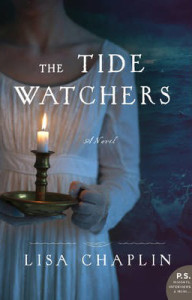 Congratulations to Angelina J who was the randomly selected winner of Lisa Chaplin’s The Tide Watchers!
Congratulations to Angelina J who was the randomly selected winner of Lisa Chaplin’s The Tide Watchers!
Look for an email from me!
Thanks to all for making my friend Lisa feel welcome.
 Congratulations to Angelina J who was the randomly selected winner of Lisa Chaplin’s The Tide Watchers!
Congratulations to Angelina J who was the randomly selected winner of Lisa Chaplin’s The Tide Watchers!
Look for an email from me!
Thanks to all for making my friend Lisa feel welcome.
I am deep in “finishing a book” mode and coming up with an interesting topic for my blog seemed impossible. So I went back to some old postings I wrote and found one worth repeating. It was from 2008 and seemed apropos since many of us will be taking vacations and visiting museums and historic sites that tend to attract crowds (like the 4th of July holiday weekend in Washington, DC).
Here’s the slightly revised post from 2008:
I opened one of my (newly rebound)Annual Registers and found this account from June 27, 1811, about what happened when the Prince Regent opened Carlton House to the public to tour the interior. I’m abridging it greatly!
(This is also apropos because I just wrote a scene where my hero walks by Carlton House with Marc Grenville from Bound by Duty!)
Yesterday being the last day that the public were permitted to view the interior of Carlton-House, the crowd from an early hour in the morning was immense; and as the day advanced, the scene excited additional interest….The gates were only opened at certain intervals and when this was the case, the torrent was to rapid, that many people were taken off their feet, some with their backs toward the entrance, screaming to get out….Lord Yarmouth and the Duke of Gloucester appeared, and announced to the public, that the gates would not be again opened…this, however, had not the desired effect….Those behind irresistibly pushed on those before, and of the number of delicate and helpless females who were present, some were thrown down, and shocking to relate, literally trod on by those behind without the possibility of being extricated. When at last the crowd got inside of Carlton-House gates, four females were found in a state of insensibility, lying on their backs on the ground, with their clothes almost completely torn off. One young lady, elegantly attired, or rather who had been so, presented a shocking spectacle; she had been trodden on until her face was quite black from strangulation, and every part of her body bruised to such a degree, as to leave little hopes of her recovery: surgical assistance was immediately had, but her life was not expected to be saved. An elderly lady had her leg broken, and was carried away in a chair; and two others were also seriously hurt, but on being bled, were restored to animation….The situation of almost all the ladies who were involved in this terrible rush was truly deplorable; very few of them could leave Carlton-House until furnished with a fresh supply of clothes; they were to be seen all round the gardens, most of them without shoes or gowns; and many almost completely undressed, and their hair hanging about their shoulders….
Can you imagine it?
Now there’s an exciting scene for one of our books.
Have you ever been in such a crowd where you feared being trampled? I’ve been at exhibits that were so crowded you couldn’t see what you came to see, but this Carlton-House visit was literally a crush!
Hope you all are enjoying your summer and I also hope no one trods on you!
One of my favorite parts of the Romance Writers of America (RWA) Annual Conference is that the Beau Monde chapter of RWA holds their annual conference the Wednesday before. I try always to attend. It is a great chance to see old friends and to hear great presentations on my favorite topics–anything about the Regency era!
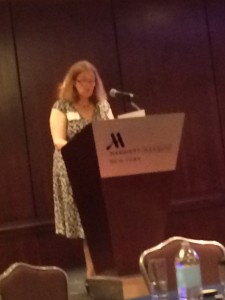 This years conference keynote speaker was Miranda Neville, who honored her recently deceased father in her speech. Her father nurtured Miranda’s interest in history and took her and her sister to museums throughout Europe as a result. If that wasn’t enough to envy, she also had an idyllic childhood on a farm in Wiltshire and went on to work for Sotheby’s, writing catalogues of rare books and original letters and manuscripts. This meant she was paid to read the personal correspondence of historical figures, including those of “our” time period. Needless to say, Miranda likes to get the history correct in her books!
This years conference keynote speaker was Miranda Neville, who honored her recently deceased father in her speech. Her father nurtured Miranda’s interest in history and took her and her sister to museums throughout Europe as a result. If that wasn’t enough to envy, she also had an idyllic childhood on a farm in Wiltshire and went on to work for Sotheby’s, writing catalogues of rare books and original letters and manuscripts. This meant she was paid to read the personal correspondence of historical figures, including those of “our” time period. Needless to say, Miranda likes to get the history correct in her books!
Our Risky Janet Mullany presented a workshop on servants, but I won’t say much about that, because she may be telling you herself. She told us about Black servants who were in England for many years. She mentioned one of the duties of footmen was to deliver messages for the lords and ladies for whom they worked. I thought it a clever fact to use in a future story that the footmen might take hours to deliver such messages, even though the distances might be nor more that a mile away.
Another Risky who presented a workshop was Isobel Carr, who spoke about the fabrics of the time period, about the different weaves of fabrics and the different materials from which they were made. Isobel has so much expertise to share on this topic, it is much too extensive for me to repeat. One interesting fact, though. We all believed that Scottish clans each had their own tartans. I imagined the clans rushing into battle at Culloden each wearing their clan’s plaids. It turns out that, in the late 18th century, a man named William Wilsons published a pattern book in which he assigned clan names to different tartans. The clans themselves had nothing to do with it.
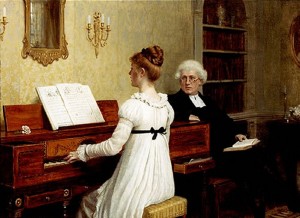 Risky friend Louisa Cornell talked about The Musical Education of a Regency Young Lady. I’ve heard Louisa speak on this topic before and I was so happy to hear Louisa, formerly a professional opera singer, sing some of the examples. She showed us what (and how) a sweet young might sing at a recital, what a talented young lady might sing, and what selections would be scandalous for a young lady to sing. Turns out, singing scandalous songs was acceptable in society.
Risky friend Louisa Cornell talked about The Musical Education of a Regency Young Lady. I’ve heard Louisa speak on this topic before and I was so happy to hear Louisa, formerly a professional opera singer, sing some of the examples. She showed us what (and how) a sweet young might sing at a recital, what a talented young lady might sing, and what selections would be scandalous for a young lady to sing. Turns out, singing scandalous songs was acceptable in society.
Jackie Horne spoke about The Material Culture of Childhood and showed how the different cultural views on childhood were reflected in their toys, furniture, and clothing. Before 1750, children were rushed to adulthood, so their furniture, clothing, etc. reflected that. 1750 to 1830 was the era of the Natural Child, the belief that childhood was a special time requiring more freedom of movement than children had experienced previously. One interesting fact Jackie told us. Baby carriages were not invented until 1830, so don’t have your Regency characters pushing one!
Cheryl Bolen shared tons of information on the interiors of Regency houses, both in Town and in the country. She showed us slide after slide of wonderful Regency interiors, including some beautiful Adams rooms. You can see these images on her Pinterest Boards. An interesting fact–her floorplan of a typical Regency town house showed that the master’s bedroom was on the ground floor behind the dining room.
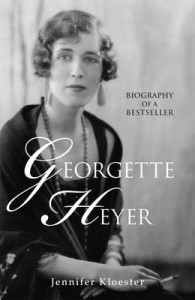 The Beau Monde was honored to have Jennifer Kloester, author of the recent acclaimed biography of Georgette Heyer. Ms. Kloester gave us a lovely picture of Heyer, including many of the insider tidbits she’d learned doing her research. She showed us a photograph of Heyer in her 20s by a then famous photographer. She looked like a 13 year old. Another photo the next year was more like the one on this book cover.
The Beau Monde was honored to have Jennifer Kloester, author of the recent acclaimed biography of Georgette Heyer. Ms. Kloester gave us a lovely picture of Heyer, including many of the insider tidbits she’d learned doing her research. She showed us a photograph of Heyer in her 20s by a then famous photographer. She looked like a 13 year old. Another photo the next year was more like the one on this book cover.
I missed the last workshop, because I needed to get ready for RWA’s huge Literacy Book Signing, but I heard it was wonderful, too. It was about Regency dance and was intriguingly titled Rethinking the Regency Ballroom with special guest Susan de Guardiola.
Miss Guardiola also led us in dance later at the evening soiree, where I joined other Beau Monde members, many in period costume, dancing the dances of the Regency. My dance partner was Joanne Grant, Senior Executive Editor at Harlequin UK. She and I have danced at previous soirees and it was a delight to have her attend this year’s and dance with me again!
It was a wonderful Beau Monde conference. Special thanks to Janna MacGregor, the coordinator of the conference. She did a marvelous job! And has become a great friend of mine, as well!
What topics would you like to hear presented at a Beau Monde conference? I’ll pass on your ideas!
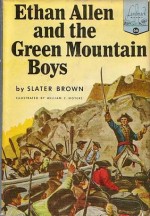 Do you remember the first book of historical fiction you ever read?
Do you remember the first book of historical fiction you ever read?
For me it was I Was There With Ethan Allen And The Green Mountain Boys. I don’t remember how old I was. Probably third or fourth grade and I can’t recall anything about the story except that it placed a boy about my age into the excitement of a dramatic moment in history. The whole premise of the series was placing a boy (not a girl) in a dramatic moment in history.
I tried to find something about the book, but it seems to have disappeared. If it has been re-released it lost the I Was There With part of the title. (This is not the correct book cover either)
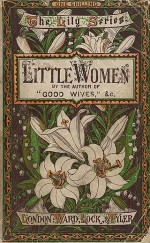 The next historically set book I fell in love with was Little Women, definitely a book to win the hearts of little girls. It did not have the excitement of the Green Mountain Boys, but I cried buckets when Beth died and I wanted to throw the book against the wall when Laurie doesn’t wind up with Jo. I think I was hot-wired for Romance fiction even then.
The next historically set book I fell in love with was Little Women, definitely a book to win the hearts of little girls. It did not have the excitement of the Green Mountain Boys, but I cried buckets when Beth died and I wanted to throw the book against the wall when Laurie doesn’t wind up with Jo. I think I was hot-wired for Romance fiction even then.
 I was also a voracious reader of Nancy Drew and Cherry Ames (anyone remember Cherry Ames books?). While technically not historicals, they took place in a time period that seemed a distant past to a little bookworm like myself. I loved that Nancy Drew drove a “roadster” and that Cherry Ames traveled to exciting places. I still remember a scene in one book where Nancy and Ned get caught in quicksand and Ned lifts her out. In Cherry Ames, I remember that head nurses were always scolding her for wearing rouge, but, you see, her cheeks were just naturally rosy.
I was also a voracious reader of Nancy Drew and Cherry Ames (anyone remember Cherry Ames books?). While technically not historicals, they took place in a time period that seemed a distant past to a little bookworm like myself. I loved that Nancy Drew drove a “roadster” and that Cherry Ames traveled to exciting places. I still remember a scene in one book where Nancy and Ned get caught in quicksand and Ned lifts her out. In Cherry Ames, I remember that head nurses were always scolding her for wearing rouge, but, you see, her cheeks were just naturally rosy.
A huge appeal for me at the time in the Nancy Drew books was her relationship with Ned Nickerson. Whenever Ned showed up, I perked up. Romance, even then. Cherry Ames had the occasional romance and I liked that part of her stories as much as the other parts.
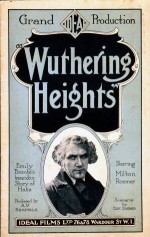 I don’t remember reading a great deal of historical books in my teen years. I read what was assigned in school and that is how I read Jane Eyre and Wuthering Heights. Both made an impression on me, because, unlike all of the above books besides Little Women, I remember the stories, but I’m not sure I can say I remember them fondly. There was cruelty in both books and I didn’t like it. And, even at a tender age, I scoffed at Jane Eyre winding up in a ditch and then getting rescued by–who else?–long lost relatives.
I don’t remember reading a great deal of historical books in my teen years. I read what was assigned in school and that is how I read Jane Eyre and Wuthering Heights. Both made an impression on me, because, unlike all of the above books besides Little Women, I remember the stories, but I’m not sure I can say I remember them fondly. There was cruelty in both books and I didn’t like it. And, even at a tender age, I scoffed at Jane Eyre winding up in a ditch and then getting rescued by–who else?–long lost relatives.
Somewhere in my teen years I also read Pride and Prejudice, but I only vaguely remembered the story.
 In college I majored in English and I focussed on English Literature as opposed to American Literature. I am woefully unread in F. Scott Fitzgerald, Ernest Hemingway, William Faulkner and John Steinbeck as a result. I did take a Black Literature course (that is what it was called in those days), for which I am profoundly grateful. I was introduced to writers I never would have read – Ralph Ellison, Maya Angelou, Langston Hughes, James Baldwin. I also read a fair amount of Thomas Hardy in college and was in the midst of an independent study
In college I majored in English and I focussed on English Literature as opposed to American Literature. I am woefully unread in F. Scott Fitzgerald, Ernest Hemingway, William Faulkner and John Steinbeck as a result. I did take a Black Literature course (that is what it was called in those days), for which I am profoundly grateful. I was introduced to writers I never would have read – Ralph Ellison, Maya Angelou, Langston Hughes, James Baldwin. I also read a fair amount of Thomas Hardy in college and was in the midst of an independent study 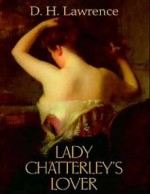 course on D.H. Lawrence when my college experienced its own dramatic moment in history. It closed early after the Kent State shootings.
course on D.H. Lawrence when my college experienced its own dramatic moment in history. It closed early after the Kent State shootings.
It took me some time to discover Regency Historicals, but once I did, I knew I’d found my home!
What was your first Historical?
And speaking of Historicals, come join the Harlequin Historical Spotlight over at eHarlequin. We’ll be chatting all month.
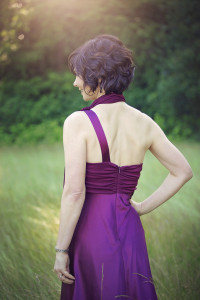 I love to feature new authors! I love it so much I gave up my blogging day to tell you about No Conventional Miss by Eleanor Webster. No Conventional Miss is Eleanor’s first published book and I’m delighted Harlequin Historical took her on! You see, Harlequin Historical has tended to back away from paranormal elements in their line, but they’ve taken the plunge with No Conventional Miss!
I love to feature new authors! I love it so much I gave up my blogging day to tell you about No Conventional Miss by Eleanor Webster. No Conventional Miss is Eleanor’s first published book and I’m delighted Harlequin Historical took her on! You see, Harlequin Historical has tended to back away from paranormal elements in their line, but they’ve taken the plunge with No Conventional Miss!
Here’s the backcover blurb for the book:
She’s always been different…
Amaryllis Gibson is an unlikely debutante. She favors fact over fashion, cares not for “proper” conversation and is haunted by ghostly visions which could land her in the madhouse! Marriage is definitely the last thing on Rilla’s mind…
But when she’s caught in a compromising position with Viscount Wyburn, suddenly she finds herself betrothed! And worse, his powerful presence only increases her visions. By shedding light on the viscount’s past, can Rilla gain his trust and win him round to her more…unconventional traits?
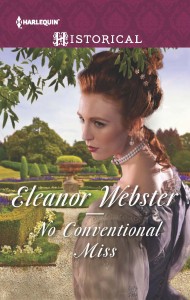 And some Goodreads reviews!
And some Goodreads reviews!
“…the perfect book to read at Hallowe’en if you like just a touch of spookiness mixed in with your historical romance.”
“…well-researched and emotionally gripping.”
“The author has spun a tale which kept my attention from beginning to end.”
Eleanor has generously agreed to give away a signed copy of No Conventional Miss to one lucky, chosen-at-random commenter from North America or the UK.
So here she is! Welcome, Eleanor!
Tell us about No Conventional Miss?
Thank you for inviting me to Risky Regencies, Diane.
The protagonist, Rilla, is a fascinating and unusual character. She is an inventor. She has a keen interest in force, momentum and any number of ‘unladylike’ activities. However, she has always been plagued with moments of second sight and rejects this aspect of herself. Indeed, a maternal aunt had been institutionalized for similar traits. A part of Rilla’s interest in the scientific is that this will serve to subdue that mystic element within her nature.
Paul is also conflicted. He believes love to be destructive based on his mother’s suicide which he thinks was caused by his parents’ unhappy marriage. Therefore, he has little interest in marriage and even less in love.
But a scandal forces the match and Rilla faces her greatest fear as she is increasingly haunted by Paul’s mother’s ghost,
The question is; can Paul and Rilla work through these challenges and achieve acceptance of self and each other or will these challenges destroy them?
This is your first book! Tell us about your writing journey and “The Call”.
My writing journey has been long, like two decades! I’m a multi-tasker which has both positive and negative aspects. I believe that one seldom has sufficient time to properly commit to one’s long term goals and, if one waits for that perfect moment, one can procrastinate into ‘never’. Therefore, each day I put aside time, however small, to write,
The downside – it took 18 years. On the flipside, I eventually made it.
‘The call’ felt surreal. I live in Canada and my editor is in England, so we had to communicate via e-mail to ensure that it wouldn’t happen at 2 a.m. Therefore, I had a good idea what was coming!
However, I believe I had quite the mega-grin at my day job that morning.
What is risky about No Conventional Miss?
No Conventional Miss is a departure from the traditional Harlequin historical because it involves a paranormal element. In fact, I was advised somewhere along my journey to remove that element from the plot as it did not fit with the traditional regency.
I have gladly accepted a lot of feedback during this journey. It is how I have learned and grown as a writer. However, this did not feel right and, although I knew it kindly meant and from a knowledgeable source, I chose not to take it. I felt that to remove it would take away that spark. In any element of life, it is a risk and takes courage to know when to take feedback and when to follow one’s own path.
Did you come across any interesting research when writing your book?
Yes, absolutely! As I described Rilla’s inventions, I wondered whether any ‘real-life’ Regency woman might be similar to Rilla. Then I found Sarah Guppy (1770-1852). Sarah was born in Birmingham and patented numerous designs. Indeed, she achieved considerable financial success, earning a contract from the British Navy worth £40,000 for a device to prevent the growth of barnacles on ships. And then there is my personal favorite; Sarah’s invention of a tea or coffee urn which also cooked eggs and warmed toast.
What is next for you?
I have a two book contract with Harlequin so a second book will be released at some point… This is set slightly earlier with the backdrop of the French Revolution.
And now a question for the readers–If you could chat with any Regency hero or heroine from any book, who would you choose and why?
Answer the question or just make a comment and you’ll be in the running for a signed copy of No Conventional Miss! (selection will be made after midnight Weds, Oct. 7)
